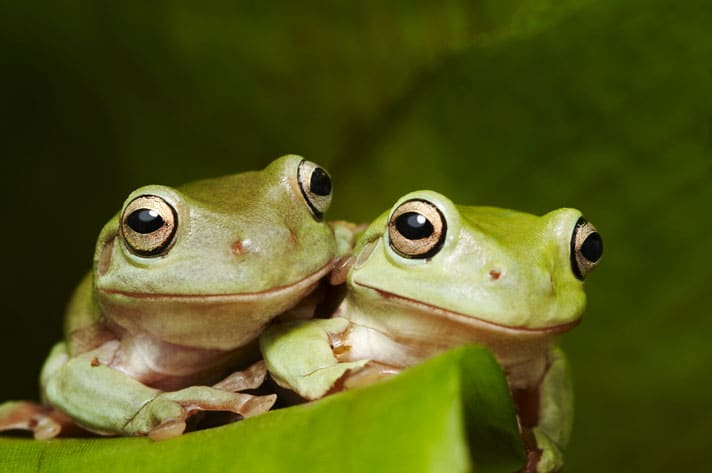White's treefrog is also known as the dumpy frog and Australian green tree frog (Litoria caerulea).
White’s treefrogs are native to northern and eastern Australia, and adjoining New Guinea. These large (3-4.5 inches) frogs are a pleasant green base color, sometimes with a bluish hue, and some individuals have spots of white or gold on the back and sides. Adults tend to have a fatty ridge above each eye, often giving them a sleepy appearance.
Read More
Availability
White’s treefrogs are generally available in the pet trade throughout the year, but captive bred specimens are most available in the summer and fall. Captive bred specimens are usually youngsters (less than 2 inches long) and should be preferred to wild caught. Wild caught frogs often carry parasites and diseases, and are not as well adapted to captive conditions.
Good sources include reptile shows, reputable pet stores, and online vendors. When selecting a frog, ask to see it eat. An actively eating, bright-eyed, plump youngster is a healthy choice. These frogs are very hard to sex when young, so if you want both sexes it is best to buy a small group of 4 or 5 animals.
Size
Adults can reach up to 5 inches, but most females top out at 4-4.5 inches in snout-to-vent length. Males are usually slightly smaller but size alone is not a good criterion for sexing these animals. Captive bred specimens are usually less than 2 inches long when sold. Males have a vocal sac, and they can have dark nuptial pads on the base of their thumbs. These may not be present in young animals though, so sexing these in the pet store or at a reptile show is difficult. Even expert breeders cannot guarantee the sex of a young frog.
Life Span
In captivity these frogs have lived over 20 years, but a more common age would be 7-10 years. They don’t have any real defensive capabilities other than camouflage, so their lifespan in the wild is likely shorter due to the risk of predation.
Caging
These hardy frogs are very forgiving when it comes to their terrarium conditions. A 20 gallon horizontal terrarium should be considered a minimum size for 4 young frogs. Treefrogs like to climb, so a taller terrarium that can accommodate larger climbing plants and branches is a good idea if possible.
White’s treefrogs are gregarious, but avoid keeping very young (small) frogs with older individuals – they are not above cannibalism.
Lighting, Temperature and Humidity
The frogs themselves do not require lighting of any kind, but if you choose to grow plants, a freshwater aquarium light is a good choice. Fluorescent models give out less heat than incandescent ones, and overheating and rapid drying can stress these frogs. There are a variety of amphibian fluorescent bulbs available from multiple herp specializing companies. A good daytime temperature is about 80 oF. This can be achieved by using a heat mat on the side of the terrarium with a thermostat, such as the Zilla Heat Mat Terrarium Heater and Zilla Terrarium Heat & Habitat Lighting Controller for Reptiles. Slightly cooler nighttime conditions will simulate temperature changes found in the wild. A tight-fitting but ventilated terrarium lid is a necessity – lack of ventilation can cause respiratory problems.
Substrate
The substrate should be a fine particulate soil or ground coconut fiber, such as Zoo Med Eco Earth Compressed Coconut Fiber Reptile Substrate. This will retain moisture well and the small particle size will not impact the frog’s gut if any is ingested accidentally.
Food
Gut-loaded crickets are a good staple food. Feed as many crickets as the frogs will eat in 10-15 minutes. For adults, feed 2-3 times per week. For youngsters, feed every 1-2 days. Earthworms are another staple food. Treat foods include waxworms, mealworms, superworms, and other live reptile foods.
Water
Humidity should be maintained by regular misting with distilled water. You can also use a water bowl (use spring water or dechlorinated tap water in bowls) in case the humidity changes suddenly and the frogs need water.
Handling and Temperament
Unlike most amphibians, White’s treefrogs tolerate handling quite well. They can even become quite accustomed to it. Due to the delicate and permeable nature of their skins, be sure your hands are soap and cream free before handling, and wash your hands well afterwards.
Reproduction and Breeding
In the wild, these frogs breed after heavy summer rains. This can be simulated with a rain chamber in captivity. Males and females meet at ponds and slow moving water bodies. The male grasps the female behind the front arms. The female lays several hundred eggs that the male fertilizes as they are produced. The eggs hatch in 2-3 days and the tadpoles feed well on aquarium fish foods in captivity. Metamorphosis takes place within 2 months for most tadpoles, but some can stay in the tadpole stage for up to a year. Metamorph froglets can be very small and require daily feeding with calcium-dusted fruit flies and pinhead crickets until they can take the staple foods mentioned earlier.
John Clare is the founder of Caudata.org and Frogforum.net.

